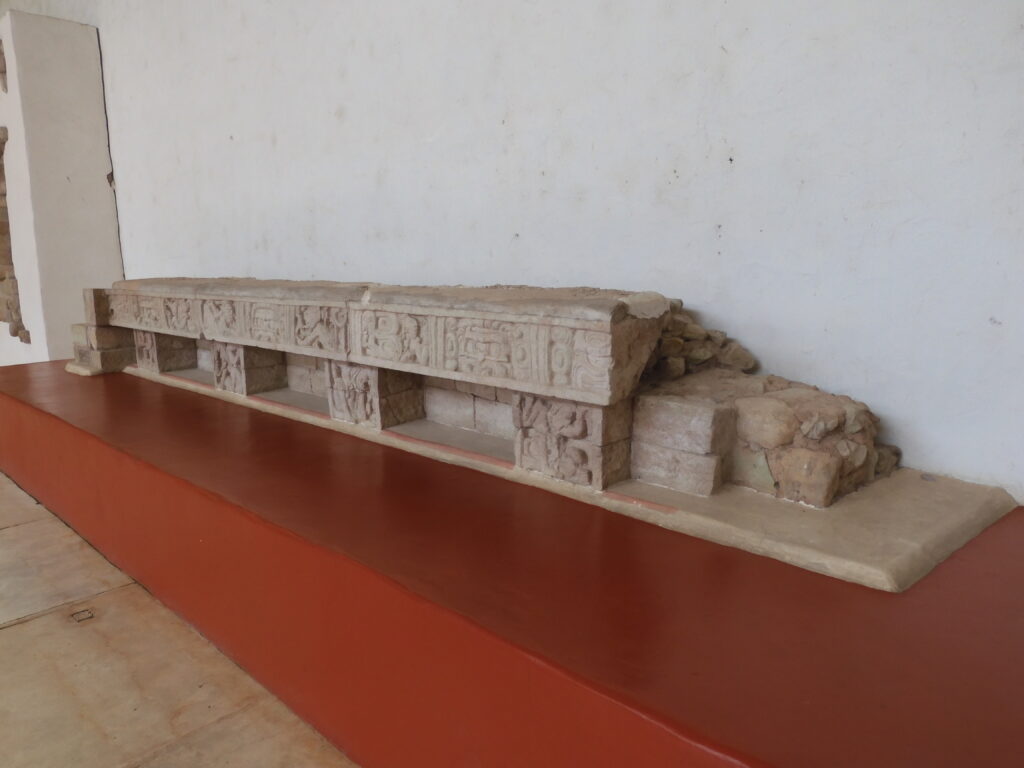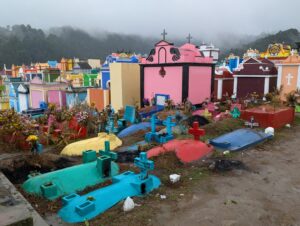Copan
Mayan City of Art & Sculpture
For a couple of weeks, I had been looking for a place to worship in Petén. This proved difficult, as the closest thing I could find was evidence that there once had been a church in Santa Elena. We had something resembling an address, but no evidence that the church was still meeting, or how to really find it. It didn’t turn up on Google maps, and addresses in Guatemala don’t work the same way they do in the U.S.
We took a colectivo over to the airport where we rented a car. Audrey had had enough colectivos and chicken buses by this point to know that she didn’t want to ride one all day. That was probably for the best. Renting turned out to be far more convenient. The only drawbacks were that I would have to navigate Guatemalan highways, and that I would have to back track with the car – a return trip that turned out to be about ten hours of high stress driving – instead of having the option to fly a puddle jumper for forty minutes from Guatemala City back to Belize.
The process of renting the car turned out to be far easier than my internet research suggested. Once I completed the brief paperwork, I drove around Santa Elena for about half an hour looking for the possibly existing Church of Christ. After asking for help finding the address at a couple of shops I was pretty sure were nearby the church’s last known address, I gave up and decided to just drive on. Our next destination was Copan Ruinas. As far as I could tell, I would have to drive about eight hours, then park, cross the border, and catch another colectivo or taxi into the small pueblo near the ruins to find a motel. The slow start and the church search meant we would almost certainly arrive in the dark. I always try to avoid this, especially in unfamiliar places.
(Continued)











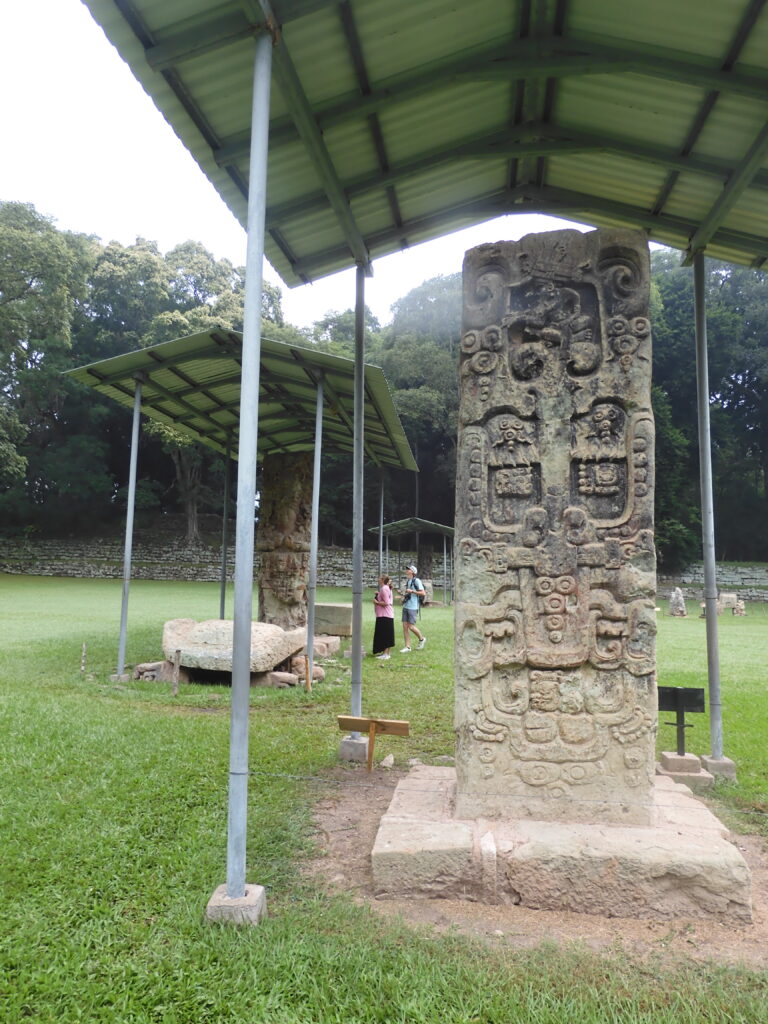




The drive was long and slow. The jungle slowly thinned and we passed through an area of pastures and plains that looked more like the Guanacaste region of Costa Rica than Petén. Although we only covered a bit over 400km, it did take about eight hours. Those were eight stressful hours. The two lane highway southward from Peten was better than I expected it to be, but there were many tight, winding, and climbing sections. Often we were stuck behind a truck climbing at less than 10kmh. We were forced to hop out into the oncoming lane to zip around him, or simply to continue at 10kmh. Everyone else was choosing the former, so I figured I should, too. We never had any extremely close calls, but we saw several other vehicles go three across a couple of times. The rickshaws and countless motorbikes did not all get a full lane, even from me. No wrecks were had, and we did eventually get to the area of the Honduran border just after dark.
My rental contract said I would have to fill out special paperwork in order to cross any national boundaries, and that arrangements would have to be made at least 48 hours in advance. I felt sure I would have to park on the Guatemalan side and find a ride the last 10 kilometers after clearing Honduran customs and immigration. It was well after dark by the time we rolled up on the Honduran border. I first came up to a rather amateur looking barrier manned by a single Guatemalteco guard. I tried to talk to him after giving my standard poor Spanish disclaimer. He never got easy to understand, however. I’m pretty sure he had been imbibing before we got there. I asked him if there was a parking lot. He said there wasn’t, and that I was unlikely to find a taxi or colectivo on the other side at this late hour (6:30). Fortunately for me, he “knew a guy” who would drive me across from the Guatemalan side. He would even “watch my car” for me if I left it parked near him. I need only suggest some sort of compensation. I went back and forth a couple of times, trying to get him to suggest a price. Finally, I asked him if Q200 was about right. He said maybe $200 would be better.
At that point, I decided to just head on up to the customs building and ask them for advice. As it turned out, no one on the Honduran side was concerned at all about anything we were doing. The guard at the border asked why I didn’t just drive the rental car across. “It has Guatemalteca placas,” he said. “Where are you going?” After learning I was just crossing to see Copan Ruinas, he just waved me on through. Customs said the same thing. So, even though I didn’t have the rental car company’s permission, I drove their car 10km into Honduras. This was by far the easiest thing to do, and everything turned out for the best. We drove right to our motel and parked underneath it, having only driven a total of 20 km in Honduras, all told.
We stayed at Acropolis Maya in the village of Copan Ruinas. Copan Ruinas looks a lot more like a typical Central American town than Flores or El Remate. It is in a highland cloud forest area with a lot of high trees and a better climate than Flores. The setting is picturesque. Our host was very helpful and suggested a parilla (grill) just across the street from the restaurant. It was a tad pricey by Honduran standards, but the quality of the facility and the customer service were excellent. The steaks sat well, and we went to bed on full stomachs.
(Continued)




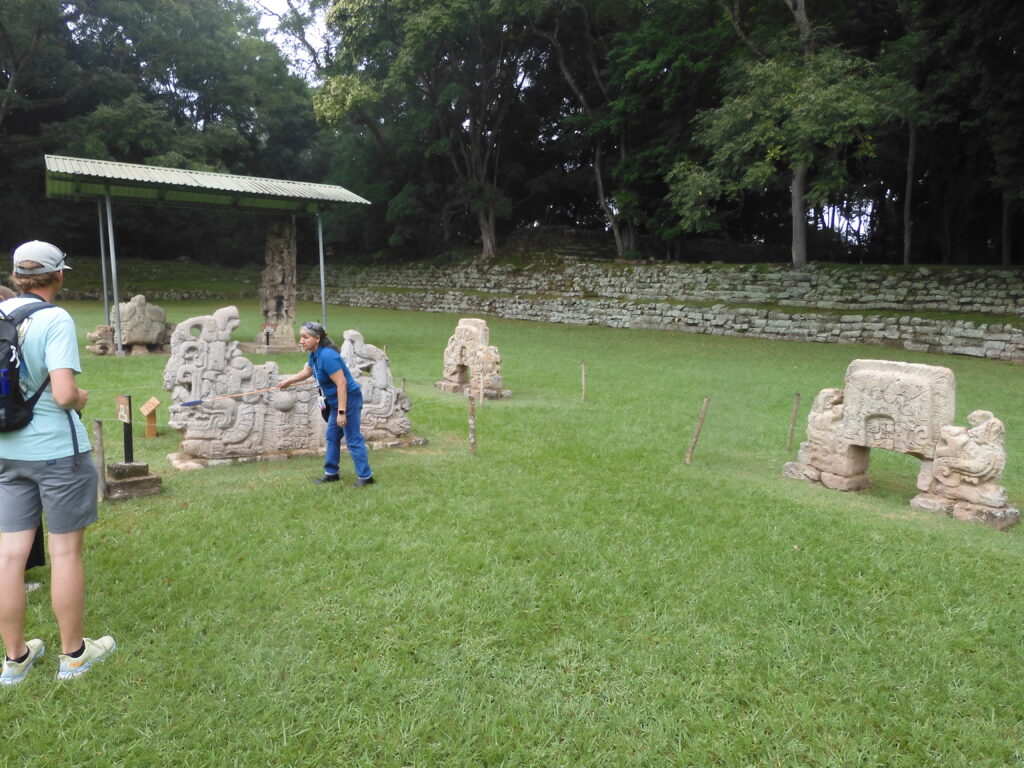







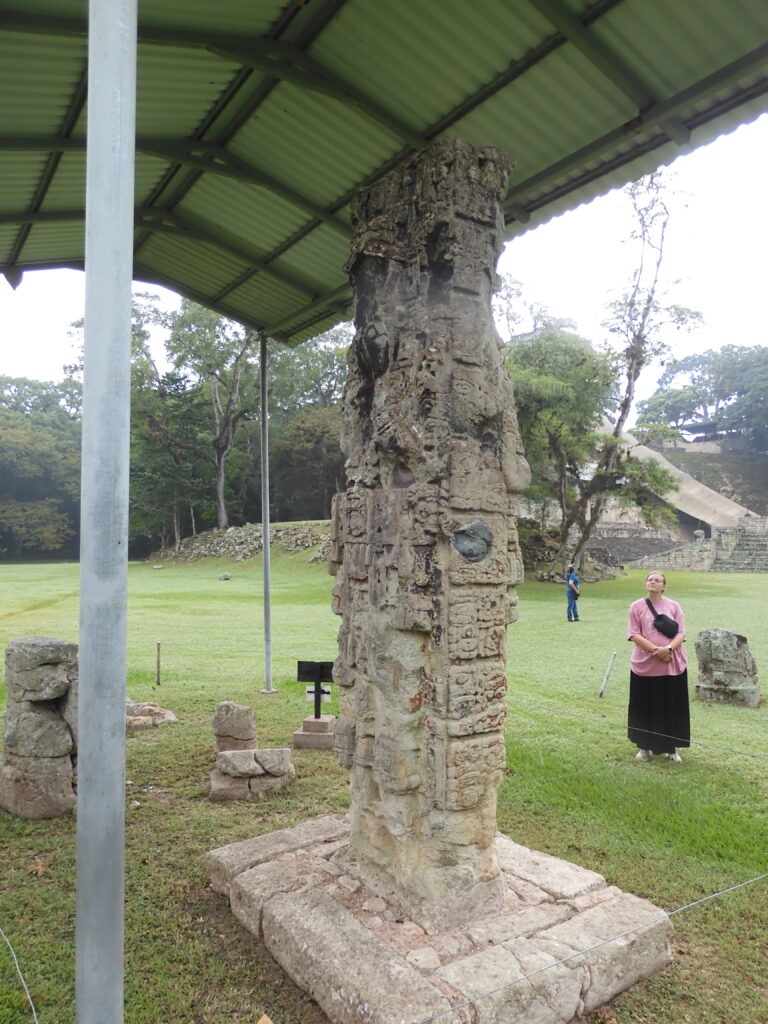



The next morning, we set out to reach the ruins around the 8:00 opening time so as to walk them in the cool of the morning. The walk from our motel to the park entry was only about a kilometer. There was a threat of rain, so we took our rain equipment, but never needed to use it. The kids hired a former elementary school teacher named Maritsa to guide us on our tour. She was a pleasant older lady, with information that seemed accurate based on what I knew of Mayan culture and history. Her English was good, so long as we stayed on her program, but got a little weaker in extemporaneous conversation. Like all guides do, she tried to hurry us along a bit. She was subtle about it though, walking ahead of us to the next stop and waiting. We just stayed at the exhibit we were looking at until we were done, and it never seemed confrontational.
Copan is known for its scarlet macaws, the national birds of Honduras. There were dozens of them, roosting, fighting, flying and playing. We moved slowly through the entry corridor looking at a few of the of the stone carvings that had been moved to this point, but mainly enjoying the beautiful birds and their play. We saw some mot mots as well, which were also beautiful.
Copan may be my favorite of the Mayan sites. Sitting along a river among misty, tree covered mountains, the setting is beautiful. The place was virtually empty throughout the day. We saw perhaps two tour groups in the four or five hours we walked the park. One of them seemed to be a local elementary school. The pyramids are in different states of restoration. Massive ceiba trees with roots penetrating the upper layers of construction prevented much work from being done in a few places. There were plenty of nicely restored buildings as well.
The highlight at Copan is not so much the buildings as the artwork. When we visited Chichen Itza and the other major Mexican Mayan sites on a previous trip, most of the original decorations had been destroyed, or at best restored. Many had been made with plaster. A large portion of the stelae and external building decorations at Copan were etched directly into more durable stone. The carvings that have survived are breathtaking and numerous. Nowhere else have I seen the anything like the original intricate Mayan artwork that remains intact at Copan. There are multiple commemorative stelae carved with historical propaganda on all four sides. There are building decorations. There are ornately carved sacrifice stones – for people as well as animals. In many places, you can still see the red, blue, or green paint they had used to further decorate them. Audrey postulated that the red on the sacrificial stones may have been caused by something else…
Continued…














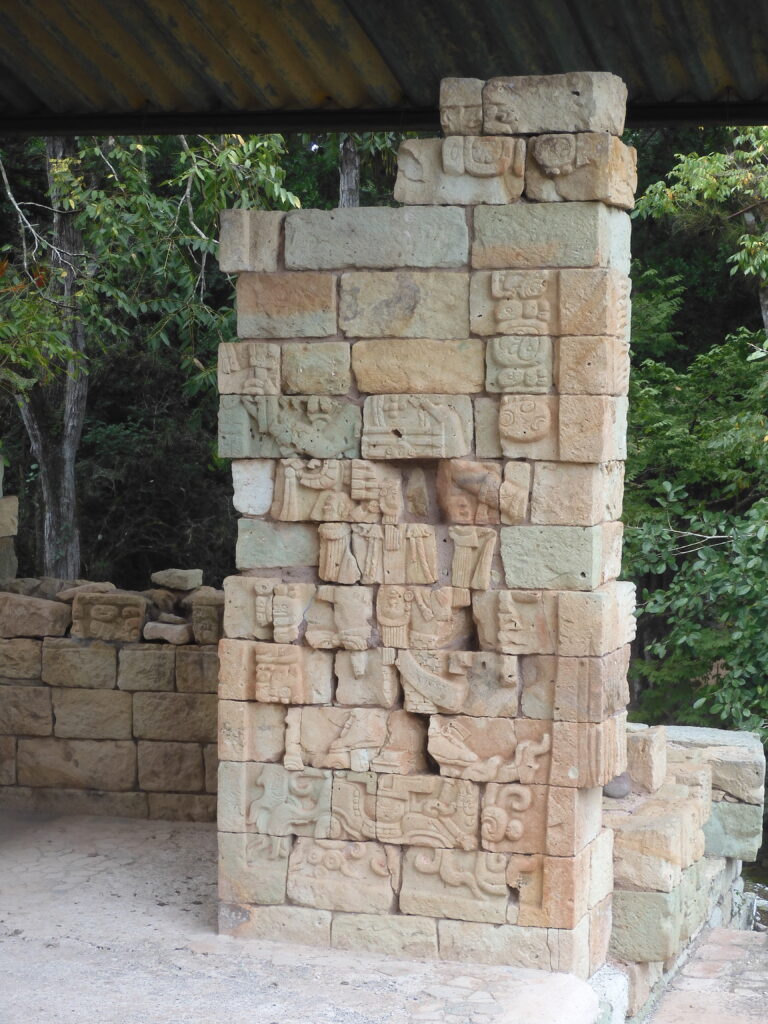

In one place, there is an entire staircase made of glyphs, the Mayan writing system. Mayans were unique in the Americas in having developed their own writing system, to go along with their mathematical, engineering, and astronomical advancements. Until the mid-twentieth century, these glyphs remained a mystery. Due to some documents preserved from destruction when they were withdrawn from a German museum about to be bombed during World War II, anthropologists learned to read most of the Mayan writing.
The best documented Mayan monarch at Copan was a fellow named 18 Rabbits. He was the 13th ruler in his dynasty, and reigned some 45 years. Many of the stelae are dedicated to his reign, or something to do with it. Although none of the information at the park said so and our guide neglected to mention it, we learned later in the museum that 18 Rabbits met his end when he was captured in battle by a neighboring city-state named Quiragua. He was subsequently a sacrifice victim.
There are a few other interesting archaeological components to Copan. There is a series of tunnels that allow you to see parts of the bases of some of the temples. Since these buildings tended to be constructed one layer over another, many of the older buildings were completely obscured. These also often contain the best preserved features as the buried older buildings were not exposed to the elements. Most of the time, only archaeologists are able to use these tunnels. Parts of a few of them are open to the public at Copan, for an extra charge. We paid the charge and visited this portion as well. Unfortunately, some of the tunnels have collapsed or been deemed dangerous and are thus no longer accessible. It was fun to get to walk through those that we could enter.
In the 1930s, the Copan River collapsed a large bank that effectively sliced one of the temples in half. While this was indeed a tragedy, there was a silver lining. It allowed archaeologists to see the insides of the temple and all of its layers. The river has subsequently been redirected to prevent further erosion damage and the collapsed portion has been stabilized to allow further examination. One of the tunnels let out into the bank, so we got to see this as well.
Continued…










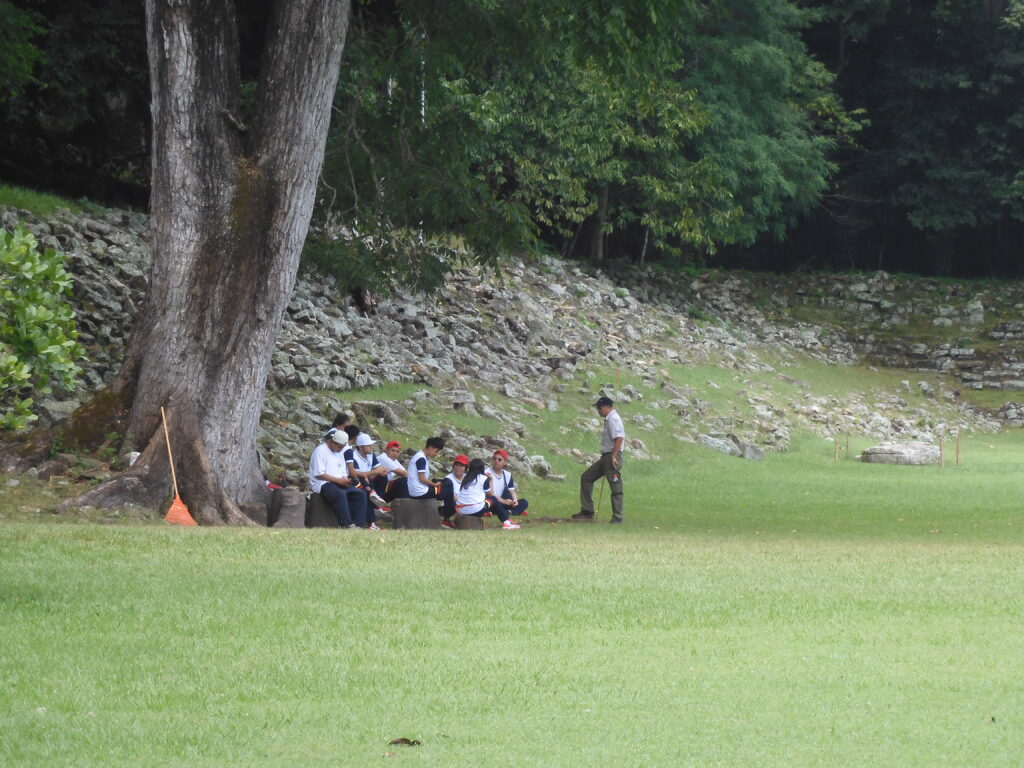



We strolled through the museum after we were done with the main park and the tunnels. Several of the stelae have been moved to the museum and replaced in the park with replicas made from molds. These are all clearly marked, so you know which is which. After we had had all we could take and found the laundry, I took Audrey back to rest in the room, and we sent Andrew to drop the laundry off. Andrew got sidetracked talking (or flirting) with the laundry girls. He was gone so long, we thought he had gotten lost – even though the laundry was just two blocks away.
He was just visiting, though, and the two sisters who were running the laundry were quite friendly. They wanted to practice their English, so once Audrey and I figured out Andrew was there we stayed and visited with Linda (24) and Rosa (14) for a couple of hours. We had such a nice time with our new friends that we asked them to join us for dinner. They told Andrew and Audrey that boleadas were a Honduran specialty, so we went to a place that served those.
The laundry was not ready until about noon, so we had a relaxed morning. We went out to breakfast for a change. Copan Ruinas is a pleasant village of about 45,000 that exhibits none of the dangerous elements Honduras is often known for. After we grabbed our clean clothes, we headed back to the Guatemalan border and passed just as trouble free as we had when we entered. No one cared where our car was from, and all we did was let two different people look at our passports to stamp them. It was a long drive to Copan, but it was a highlight of the trip and absolutely worth the time.











